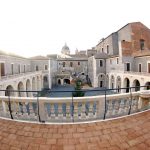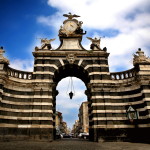The walls of Charles V
- 3:00 h
- 5,4 KM
- Easy
Enter the city as a citizen of Catania in the sixteenth century.
No, it’s not a joke. Catania is a city rich in history and we want to tell you about the emperor Charles V. When he ordered the building of mighty fortifications that could resist Turk attacks with seven doors and eleven bastions.
From Charles V door to the Ursino Castle, follow the trail marked by new and old buildings.
Charles V entrance (or Canals’ one)
The Charles V entrance is the only one of the seven that made up the ancient city’s walls, still exists. The construction of the walls began in 1541 by the viceroy Vega with the aim of improving the defensive capability of the city against pirates who frequently attacked the coast of Catania.
Visiting the Pescheria? Enter the market from this Renaissance door.
Uzeda gate (porta Uzeda)
Uzeda gate connects the two parts of the old Clerks’ seminary, it was built in 1695 by the Duke of Camastra and was dedicated to the Viceroy Paceco Uzeda. It’s considered a symbol of the city and it is built in typical Catania baroque style: lava stone and white marble.
Port of Catania
Located in the centre of the Mediterranean Sea, the Port of Catania was first built in 1438. Repeatedly rebuilt over the centuries, today it is one of the most important ports in Sicily. With a total surface area of 615,000 m2, the Port is home to a variety of different activities
Palazzo della Cultura
After the terrible earthquake in 1693, the remains of the former San Placido’s Monastery and the oldest Platamone’s palace were integrated each other to realize the Palazzo della Cultura. The palace still presents some elements in late medieval style.
Piazza Stesicoro
Piazza Stesicoro takes its name from the Greek poet Stesichorus. It is crossed and divided in two parts by the main street, via Etnea. The two sides of the square have different architectural styles: on East stands the monument dedicated to Vincenzo Bellini, on the other side the roman amphitheatre.
Slope of via Cappuccini
“Cchianata de’ Cappuccini” is an important place during the celebrations in honour of Saint Agatha. It starts in via Cappuccini, near Piazza Stesicoro, and it continues with via Pietro Garofalo creating the form of a steep “S”. At the end of the slope there is via Santa Maddalena.
To be visited during the celebrations of St. Agatha, in February, to admire the rush of devotees.
Bastion of Infetti
The bastions were built in Catania in the early sixteenth century by Emperor Charles V of Spain. The Bastion of Infetti (infected) is the best preserved among the eleven bastions that, together with seven gates, formed the defensive system of Catania.
Porta Garibaldi (Garibaldi’s gateway)
At the end of Via Garibaldi there’s a triumphal arch, it was erected in 1768, mistakenly called “Gateway of Garibaldi” or “King Ferdinand’s one” (because it was built to celebrate the wedding between Prince Ferdinand IV and Maria Carolina of Austria) but it’s better known to people of Catania as “porta ‘o Furtinu”.
Ursino Castle
Between 1239 and 1250, Frederick II ordered to build the Ursino Castle for defensive purpose of the East coast of Sicily and it was on a promontory surrounded by sea. In 1669, the eruption gets the Castle away from the sea.
The museum often houses temporary exhibitions and events that melt with the permanent one. To be visited.








